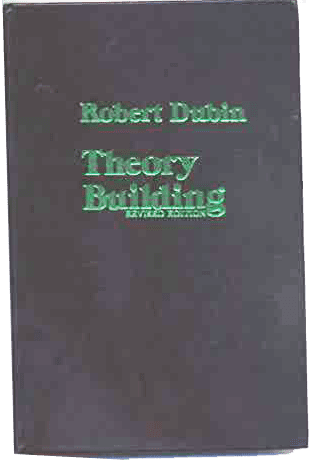
| Author | Robert Dubin |
| Publisher | Generic Printing |
| language | English |
| Book Type | Paperback |
| ISBN-13 | 978-0029076309 |
| Pages | 236 |
Robert starts his book ( theory building) illustrating the source of a hypothesis to test a theory, theory correlation to hypothesis testing, the operation of the theory units, laws they interact with, boundaries of a theory, and the system state they all interact in. He emphasizes the use of logic theories in building a model, procedure to match a model in the real world, how to construct a theory to through modeling observations, as well as proving the theory by empirical tests.
In further detail he focuses on the first purpose of his book, making the distinction between asking questions and a theory. As research is based on a research question, he presents the two distinction differences of the benefit of research for theory and how theory serves research. Major parts of the book are centered around theory building in social science and minor areas on construction of math and chemistry models and theories. In social science behavior, the role of precision paradox and power paradox are examined and tested, defining the vital relationship of power paradox and prediction process in one of the book chapters.
Robert expands in his detail analysis to articulate the notion of transforming the understanding of a concept and turning it to a unit, how theories are built on properties of an object rather than the object. In this context units may be a variable or an attribute, unit types are primitive or sophisticated. In defining all the theory construction process in detail; this theory components are subject to laws of interaction and every theory is affected by different types of interactions. Laws of interactions have a direct correlation to the level of efficiency in theory operations. These laws and interactions introduce a problem in theory building the problem of independency from other science and the required level of analysis as many theories interact with other types of sciences in operations. He describes and analysis the shared boundary criteria by units and law models, and the types of boundaries theoretical and empirical.
Since every theory is influenced by other sciences, it became an individual system. He provides valid answers to these questions: what is a system? What types of system there are? How to analyze these systems?” And the difference of purpose and goal in analyzing a system. The system works in certain state; the system state that contains all regions within the boundary, and the format of indicating system states. Before going to the final stages of the theory building Robert defines various propositions and its relation to laws of interaction, how these propositions are used to predict a value of a unit and further to that direct relationship between propositions and hypothesis and strategies used to build them.
He finally reaches the final stage of theory building by defining what an indicator, types of indicators, is and how to build them. He defines a clear understanding of the distinctive differences between research and theory; distinguish between theoretical research (theory building) and empirical research (theory testing).
The only catch I have on this book is in some areas of the book the ideas are not in hierarchy, so you need full focus to link the ideas of the theory building as he is explaining high level knowledge for PHD level and up. For further reading on the efficient procedure to write a book review read my article click here.
[…] Theory Building: A Practical Guide to the Construction .. […]